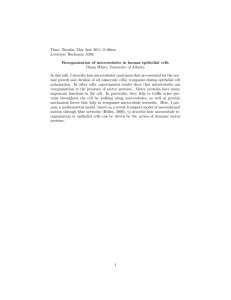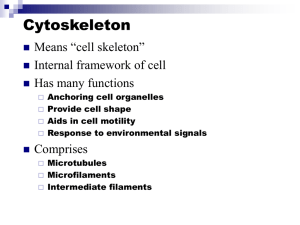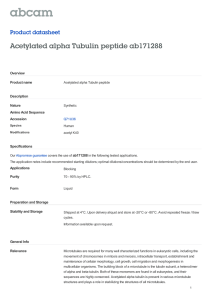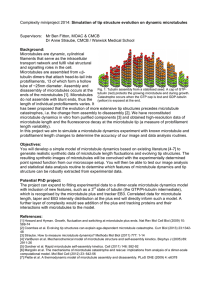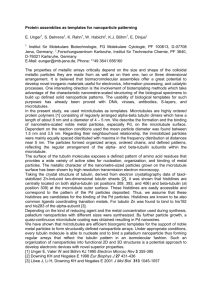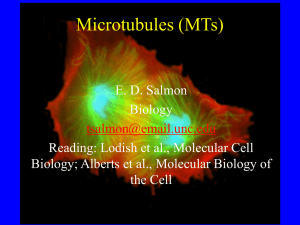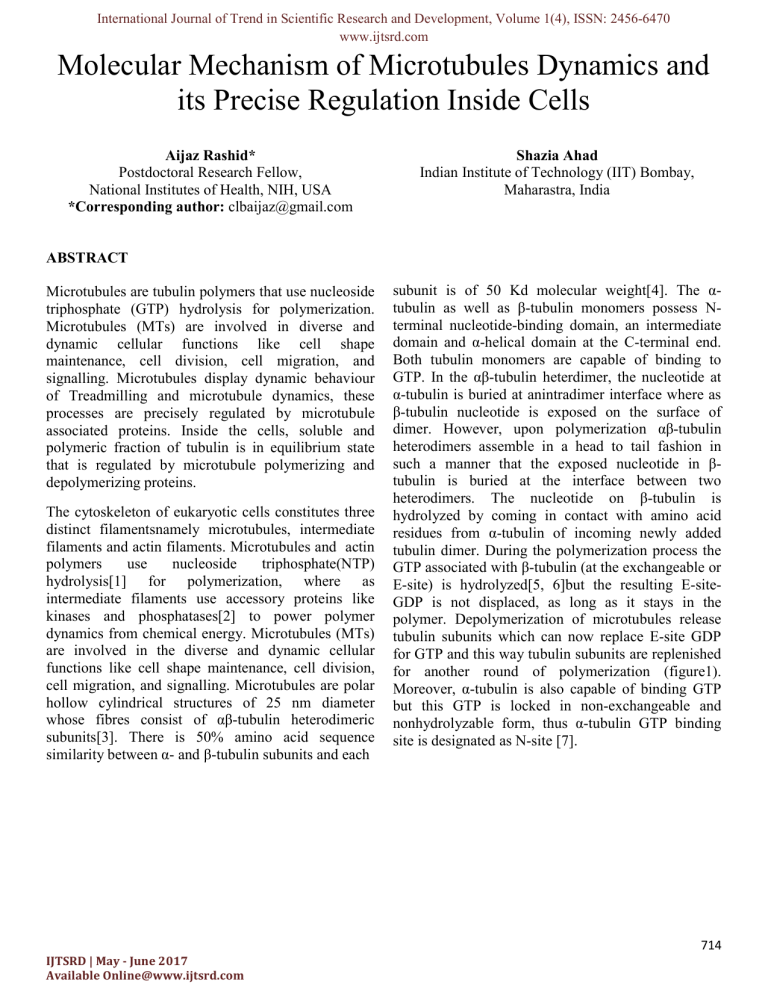
International Journal of Trend in Scientific Research and Development, Volume 1(4), ISSN: 2456-6470
www.ijtsrd.com
Molecular Mechanism of Microtubules Dynamics and
its Precise Regulation Inside Cells
Aijaz Rashid*
Postdoctoral Research Fellow,
National Institutes of Health, NIH, USA
*Corresponding author: clbaijaz@gmail.com
Shazia Ahad
Indian Institute of Technology (IIT) Bombay,
Maharastra, India
ABSTRACT
Microtubules are tubulin polymers that use nucleoside
triphosphate (GTP) hydrolysis for polymerization.
Microtubules (MTs) are involved in diverse and
dynamic cellular functions like cell shape
maintenance, cell division, cell migration, and
signalling. Microtubules display dynamic behaviour
of Treadmilling and microtubule dynamics, these
processes are precisely regulated by microtubule
associated proteins. Inside the cells, soluble and
polymeric fraction of tubulin is in equilibrium state
that is regulated by microtubule polymerizing and
depolymerizing proteins.
The cytoskeleton of eukaryotic cells constitutes three
distinct filamentsnamely microtubules, intermediate
filaments and actin filaments. Microtubules and actin
polymers
use
nucleoside
triphosphate(NTP)
hydrolysis[1] for polymerization, where as
intermediate filaments use accessory proteins like
kinases and phosphatases[2] to power polymer
dynamics from chemical energy. Microtubules (MTs)
are involved in the diverse and dynamic cellular
functions like cell shape maintenance, cell division,
cell migration, and signalling. Microtubules are polar
hollow cylindrical structures of 25 nm diameter
whose fibres consist of αβ-tubulin heterodimeric
subunits[3]. There is 50% amino acid sequence
similarity between α- and β-tubulin subunits and each
subunit is of 50 Kd molecular weight[4]. The αtubulin as well as β-tubulin monomers possess Nterminal nucleotide-binding domain, an intermediate
domain and α-helical domain at the C-terminal end.
Both tubulin monomers are capable of binding to
GTP. In the αβ-tubulin heterdimer, the nucleotide at
α-tubulin is buried at anintradimer interface where as
β-tubulin nucleotide is exposed on the surface of
dimer. However, upon polymerization αβ-tubulin
heterodimers assemble in a head to tail fashion in
such a manner that the exposed nucleotide in βtubulin is buried at the interface between two
heterodimers. The nucleotide on β-tubulin is
hydrolyzed by coming in contact with amino acid
residues from α-tubulin of incoming newly added
tubulin dimer. During the polymerization process the
GTP associated with β-tubulin (at the exchangeable or
E-site) is hydrolyzed[5, 6]but the resulting E-siteGDP is not displaced, as long as it stays in the
polymer. Depolymerization of microtubules release
tubulin subunits which can now replace E-site GDP
for GTP and this way tubulin subunits are replenished
for another round of polymerization (figure1).
Moreover, α-tubulin is also capable of binding GTP
but this GTP is locked in non-exchangeable and
nonhydrolyzable form, thus α-tubulin GTP binding
site is designated as N-site [7].
714
IJTSRD | May - June 2017
Available Online@www.ijtsrd.com
International Journal of Trend in Scientific Research and Development (IJTSRD) ISSN: 2456-6470
+ (end)
13 Protofilaments
Microtubule
24 nm
Lateral association
of protofilaments
15 nm
- (end)
Microtubule
depolymerization
β-tubulin(
)
α-tubulin(
)
Protofilament formation
αβ-tubulin heterodiamer
Microtubule
polymerization
GTP
Nucleation step
Figure
1:
Microtubule
disassembly
and
reassembly: The end of microtubule containing βtubulin subunit is designated as plus end and opposite
side is denoted as minus end of the microtubule.
Microtubules are dynamic polymers which once
undergo depolymerization release heterodimeric αβtubulin subunits. The disassembled αβ-tubulin
subunits released from microtubules are replenished
with GTP and now they can act as building blocks for
new microtubule formation. This microtubule
polymerization process is a nucleation mediated
phenomenon in which ultimately 13 protofilaments
composed of αβ-tubulin subunits combine to
constitute a microtubule. There are non-covalent
lateral interactions among 13 protofilaments, which
combine together to make a hollow cylindrical
microtubule, with internal diameter of 15 nm and
outer diameter of 24 nm.
Microtubules display two main dynamic properties:
dynamic instability and treadmilling (figure 2 and
figure 3)[8, 9]. Dynamic instability is a process
where microtubule ends switch between the phases of
growth and shortening[8]. Microtubule dynamics is
characterized by four main parameters: growth and
shortening rates, catastrophe and rescue frequency.
The parameter called ‘dynamicity’ is used to describe
the overall rate of tubulin subunits exchange at
microtubule ends. The dynamic instability model[8]
of microtubule assembly suggests that the individual
microtubules exist either in an elongation state or a
rapidly shortening state, with abrupt and random
transitions between these two states. The transition
between growth and shrinkage has been revealed to be
controlled by the structure of the microtubule ends.
One end of microtubule which is referred as (+) end
grows more than other end designated as (-) end. As
tubulin dimers add to the growing (+) end, the βtubulin-bound GTP is hydrolyzed so that at a
particular time only a short stretch of β-tubulin-GTP
is present at the tip of microtubules, which creates a
'GTP cap' that prevents microtubules from
depolymerization. The GTP-bound end of a growing
microtubule forms an open sheet that closes to form a
715
IJTSRD | May - June 2017
Available Online@www.ijtsrd.com
International Journal of Trend in Scientific Research and Development (IJTSRD) ISSN: 2456-6470
tube like structure where it joins the microtubule
shaft[10, 11]. However, if the subunit addition is
slower than the rate of GTP hydrolysis, the
microtubule end will contain only GDP-bound βtubulin, which further results inprotofilament
unwinding and microtubule catastrophe. Although
both ends of microtubule are capable of growth and
shortening, the changes in length at the plus end is
much greater than the other end (figure 2).
Microtubules exhibit another important dynamic
behaviour called treadmilling which corresponds to a
polymer mass steady state resulting from the growth
of microtubule at one end and simultaneous and
equalshortening of microtubule at the opposite end. In
other words, treadmilling is a process by which
tubulin subunits continuously flux from one end of the
polymer to the other, due to net differences in the
critical concentrations at the opposite microtubule
ends (figure 3). Dynamic instability of microtubules
can be depicted in a graphical form as represented in
figure 2b. The different parameters of microtubule
dynamics are shown. Microtubules increase in length
for some time and this phase is referred as growing
phase of microtubule and slope of this phase represent
growth rate. In the course of microtubule growth, it
stops growing or shortening for some time and this
phase is represented as pause stage. Although it is
believed that mild addition or removal of tubulin
dimers might occur during this phase but our
microscopic techniques are limited to visualise it due
to poor resolution. The phase in which microtubule
depolymerizes is called as shortening or catastrophic
phase and its slope represent shortening rate. The
frequency of transition from growth or pause to
shortening is called as catastrophe, whereas the
frequency of transition from shortening to growth or
pause is called as rescue. The total change in the
microtubule length (overall dimer exchange) per
minute is known as microtubule dynamics [12]. Our
understanding of microtubule dynamics was
complemented by different techniques like electron
microscopy and other fluorescence microscopy
techniques along with optimization of buffering
conditions helped to examine this important
phenomenon at individual microtubule level both in in
vivo and in vitro conditions [8, 12-19]. Sea urchin
sperm axonemes are stable microtubule nucleating
filaments which helped us to monitor microtubule
dynamics in the in vitro system. The newly
originating microtubules from axonemes could be
videoed and different events of microtubule dynamics
can be easily studied [8, 13]. In cells, the expression
of GFP-tubulin, EGFP-tubulin or microinjection of
rhodamine or biotin labelled tubulin have emergedas
important strategic tools to understand microtubule
dynamics and the role played by microtubule
dynamics in cell functioning [19-21].Time lapse
imaging of GFP-tagged visible microtubules is
recorded by using confocal or a total internal
reflection fluorescence microscope, which is coupled
with a CCD camera and a temperature controller. An
image of same region of cell is taken at a fixed
interval of time and a video is made. Then the growth
of individual microtubule is noted by tracking the tip
of microtubules in each time frame to locate the
specific location of microtubules in x-y plane. The
change in microtubule length over time is plotted to
obtain life history tracks of microtubules and from
which different microtubule dynamic instability
parameters are calculated. Further, the intrinsic
dynamic characteristic of microtubule is important for
assembly of mitotic spindle, proper attachment of
microtubules with kinetochore and segregation of
chromosomes.
Microtubule dynamics is regulated by a family of
cellular proteins which though perform distinctly
different cellular functions like some proteins act as
oncogenes, tumor suppressors or apoptotic regulators
etc, but together these proteins modulate microtubule
dynamics for proper cell functioning. Over-expression
of some of the MAPs in certain tumours not only
imparts resistance to microtubule drug targeting
therapy, but it is also responsible for disease
progression. The mechanism by which MAPs render
MTAs unsuccessful could be exploited for rational
drug design. The alteration of microtubule dynamics
by microtubule targeting agents is well known
strategy to cure cancer growth and metastasis. The
combination of siRNA against specific MAPs along
with use of MTAs can be utilized to generate cancer
specific cytotoxic effects without harming normal
cells via using specific drugs or siRNA targeting or
delivery strategy. Importantly, the vinblastine and
taxol binding agents are widely used successful
anticancer agents.
716
IJTSRD | May - June 2017
Available Online@www.ijtsrd.com
International Journal of Trend in Scientific Research and Development (IJTSRD) ISSN: 2456-6470
(A)
(B)
Pause
Dynamic end of microtubule
Figure 2: Dynamic instability of microtubules: (A) Microtubules undergo continuous rounds of growth and
catastrophe depending on the presence of GTP or GDP cap at the tips of microtubules. As long as GTP cap is
present at the tip of microtubule, it will grow in length and then at the sometime it loses GTP cap and
undergoes catastrophe. During the course of depolymerization microtubule can regain GTP cap and resume
growth. (B) The pictorial representations of microtubule length change over time, showing addition of GTP
bound αβ-tubulin subunits during growth phase of microtubule and during depolymerization or catastrophe
GDP bound αβ-tubulin subunits are released. Pause state represents a phase of microtubule where no net
change in microtubule length is visualised. It is to be noted that all the additions and removal of GTP or GDP
bound tubulin occur only at the ends of microtubules as shown in the representative microtubule.
717
IJTSRD | May - June 2017
Available Online@www.ijtsrd.com
International Journal of Trend in Scientific Research and Development (IJTSRD) ISSN: 2456-6470
∆MT Length = ∆L
Influx of tubulin subunits
∆L = 0
∆L = 0
∆L = 0
∆L = 0
∆L = 0
∆L = 0
Figure 3: Treadmilling: It represents net polymer
mass steady state, which is outcome of microtubule
growth at one end and shortening from opposite end.
In other words, treadmilling is a process by which
tubulin subunits continuously flux from one end of the
polymer to the other, due to net differences in the
critical concentrations at the opposite MT ends. Flux
of αβ-tubulin subunits is represented in black color
and tubulin subunits treadmill through microtubule
length and are released through (-) end of
microtubule.
Microtubule dynamics and its regulation inside
cells
Although microtubules are intrinsic dynamic
polymers but programmed regulation of microtubule
dynamics through different phases of cell cycle is
modulated by numerous proteins known as
microtubules associated proteins (MAPs) and mitotic
kinases[22, 23]. Various MAPs present inside the cell
maintain a balance between polymeric and soluble
pool of tubulin and are also responsible for
reorientation of microtubule cytoskelton (figure 4).
There are three classes of MAPs, microtubule
stabilizing proteins, end binding proteins and
microtubule depolymerizing MAPs. Microtubule
stabilizing proteins aid in tubulin polymerization as
well as stabilization of microtubules by shifting
equilibrium towards polymerization state. Whereas,
microtubule stabilizing MAPs reduce the catastrophe
frequency and increase the growth rate of the
microtubules [24-26]. Moreover, some of the
Out flux of tubulin subunits
remarkable examples of this class of MAPs are MAP
1, MAP 2, MAP 4, MAP 7 and tau, all of them are
known to bind along the microtubule lattice and
regulate the microtubule dynamics by stabilizing and
promoting microtubule bundle formation(figure 4).
MAPs have specific microtubule binding domains by
which they bind to microtubules. The distribution of
these MAPs could be specific to particular type of
cells or they may be randomly present in all cells.
Notably, the example is tau, which is particularly
present in the axonal cells, whereas MAP-2 is present
in the dendrite cells [24-26]. Tau a neuronal protein is
one of the extensively studied proteins. Tau stabilizes
neuronal microtubules and its affinity with
microtubules is regulated through phosphorylation.
The altered phosphorylation of tau is responsible for
Alzhimers disease and other tauopathies. Tau
regulates microtubule dynamics by reducing the rates
of growth and shortening with simultaneous increase
in time spent by microtubules in the pause state[27].
There
are
several
other
post-translational
modifications which can occur with tau protein like
phosphorylation,
glycation,
ubiquitination,
acetylation, nitration, truncation, glycosylation and
polyaminations. However, the most predominant one
is tau phosphorylation which regulates its interaction
with
the
microtubules.
Tau
undergoes
phosphorylation on serine and threonine residues.The
hyperphosphorylated serine and threonine residues of
tau proteins could be a cause for neurodegenerative
diseases by destabilizing microtubules due to
electrostatic
interference
in
polymerization.
Moreover, the phosphorylation of tau also interfers
718
IJTSRD | May - June 2017
Available Online@www.ijtsrd.com
International Journal of Trend in Scientific Research and Development (IJTSRD) ISSN: 2456-6470
with binding ability of tau to microtubules as
compared to non-phosphorylated tau. Glycogen
synthase kinase 3(GSK-3) is responsible for tau
phosphorylation;it phosphorylates tau on serine and
threonine residues. GSK-3 is also linked with βamyloid formation in neurons, thus it could be an
important contributor in neurodegeneration[28].
However, the other important regulators of
microtubule dynamics are tracking proteins called as
plus end binding proteins (+TIPS) which consists of
EB family of proteins, CLIP family of proteins like
CLIP-170
(cytoplasmic
linker
protein170),
CLASP(cytoplasmic linker associated proteins), APC
(adenomatous polyposis coli), XMAP215 (Xenopus
microtubule associated protein 215) anddynamitin.
Plus end tracking proteins are known for specific
binding and recognization of GTP cap structure
present at microtubule plus end. These proteins have
been reported to regulate microtubule growth and
dynamics. Specific domains are involved for tracking
and binding of +TIPs proteins at the plus end of the
microtubules. The important examples are end
binding proteins which bind through calponin
homology domain (CH), XMAP215 bind through
TOG (tumor overexpressed genes) domain and CLIP170 binding involves CAP-Gly domain[29]. EB1 an
important member of EB family of proteins is a +TIP
which binds at the tip of dynamic microtubules and
form a comet like shape at the growing end[30, 31].
The EB1 forms a comet and thus regulates
microtubule dynamics also. This comet formation also
help in important processes like cargo transport and
cell signaling during cell migration. Catastrophe
frequency of microtubules is decreased by EB1[32]
and it promotes tubulin polymerization. The
importance of GTP hydrolysis for plus end tracking of
EB1 was established by using non-hydrolysable
analogue of GTP (GMPPCP) which hampered EB1
tracking ability, suggesting EB1 recognization of
some important structural feature in GTP-cap[33].
Regulation of microtubule dynamics during mitosis
by XMAP-215 and mitotic kinases like aurora kinases
and polo like kinases help in proper chromosomal
segregation and cell division [34-36]. Kinesins are
minus end directed motor proteins and dyneins are
directed towards plus end of microtubule, these cargo
carrying proteins also regulate microtubule
dynamics[37]. The kinesins and dyneins use
microtubules as tracks on which they carry different
cargoes from one compartment of cell to another. An
individual component of dynein motor called as LC8
was found to interact and stabilize microtubules
indicating possible regulation of microtubule
dynamics by LC8 association with microtubules[38].
In addition to microtubule polymerization promoting
MAPs, there are microtubule depolymerizing MAPs
which upon binding to microtubule depolymerizes it
[39-44], important examples are Kinesin-13 family
proteins (Kif2A, Kif2B, MCAK) which upon binding
to microtubules cause depolymerization. Kinesin-13
family proteins also sequester the tubulin monomers
and
increase catastrophe frequencies of
microtubules[40, 41]. Length based microtubule
depolymerization is carried over by Kinesin 8 family
proteins [42]. Kinesin proteins are known for their
important functions during mitosis as they help in
proper bipolar spindles orientation and hence
chromosome segregation. Katanin depolymerizes
microtubules by forming a ring like structure on
microtubule lattice. The activation of ATPase activity
of katanin leads to severing of microtubules[43]. End
binding followed by depolymerization is carried out
by Kin I kinesin family members like XKCM1 and
MCAK[45]. Op18 (oncoprotein 18 or stathmin) forms
a ternary complex with tubulin and sequesters the
tubulin heterodimer, thereby making them unavailable
for polymerizationthus, shifting the equilibrium of
microtubule assembly towards depolymerization
state[44].
719
IJTSRD | May - June 2017
Available Online@www.ijtsrd.com
International Journal of Trend in Scientific Research and Development (IJTSRD) ISSN: 2456-6470
End binding proteins
Polymeric tubulin
Severing proteins
Lattice binding microtubule stabilizing and destabilizing proteins
Soluble tubulin
Monomer sequestering protein
Figure 4: Polymerization equilibrium: Inside the
cells, cytosolic and polymeric fraction of tubulin is in
an equilibrium state. Microtubule polymer dynamics
is maintained by continuous addition and removal of
tubulin subnits. There are broadly four categories of
proteins regulating microtubule polymerization. End
binding proteins like CLIP-170, EB1 bind at the ends
of microtubules and regulate microtubule dynamics
and polymerization. Microtubule lattice binding
proteins are either microtubule stabilizers like Tau,
MAP4 or microtubule depolymerizing proteins like
MCAK. There are microtubule severing proteins also
likekatanin, which binds to microtubule and forms a
ring like structure around the microtubules and
ultimately resulting in the cleavage of microtubules.
Microtubule polymerization is also regulated by
sequestration of tubulin subunits by stathmin (Op18).
REFERENCES
1) Mitchison, T.J., Compare and contrast actin
filaments and microtubules. Mol Biol Cell. 1992
Dec;3(12):1309-15., 1992.
2) Eriksson, J.E., P. Opal, and R.D. Goldman,
Intermediate filament dynamics. Curr Opin Cell
Biol. 1992 Feb;4(1):99-104., 1992.
3) Desai, A. and T.J. Mitchison, Microtubule
polymerization dynamics. Annu Rev Cell Dev
Biol. 1997;13:83-117., 1997.
4) Burns, R.G., Alpha-, beta-, and gamma-tubulins:
sequence comparisons and structural constraints.
Cell Motil Cytoskeleton. 1991;20(3):181-9.
5) David-Pfeuty, T., H.P. Erickson, and D. Pantaloni,
Guanosinetriphosphatase activity of tubulin
associated with microtubule assembly. Proc Natl
Acad Sci U S A. 1977 Dec;74(12):5372-6.
720
IJTSRD | May - June 2017
Available Online@www.ijtsrd.com
International Journal of Trend in Scientific Research and Development (IJTSRD) ISSN: 2456-6470
6) MacNeal, R.K. and D.L. Purich, Stoichiometry
and role of GTP hydrolysis in bovine neurotubule
assembly.
J
Biol
Chem.
1978
Jul
10;253(13):4683-7.
7) Spiegelman, B.M., S.M. Penningroth, and M.W.
Kirschner, Turnover of tubulin and the N site GTP
in Chinese hamster ovary cells. Cell. 1977
Nov;12(3):587-600.
8) Mitchison, T. and M. Kirschner, Dynamic
instability of microtubule growth. Nature. 1984
Nov 15-21;312(5991):237-42., 1984.
9) Margolis, R.L. and L. Wilson, Opposite end
assembly and disassembly of microtubules at
steady state in vitro. Cell. 1978 Jan;13(1):1-8.
10) Chretien, D., S.D. Fuller, and E. Karsenti,
Structure of growing microtubule ends: twodimensional sheets close into tubes at variable
rates. J Cell Biol. 1995 Jun;129(5):1311-28.
11) Mandelkow, E.M., E. Mandelkow, and R.A.
Milligan, Microtubule dynamics and microtubule
caps: a time-resolved cryo-electron microscopy
study. J Cell Biol. 1991 Sep;114(5):977-91.
12) Gardner, M.K., M. Zanic, and J. Howard,
Microtubule catastrophe and rescue. Curr Opin
Cell
Biol.
2013
Feb;25(1):14-22.
doi:
10.1016/j.ceb.2012.09.006. Epub 2012 Oct 22.,
2013.
13) Walker, R.A., et al., Dynamic instability of
individual microtubules analyzed by video light
microscopy: rate constants and transition
frequencies. J Cell Biol. 1988 Oct;107(4):143748., 1988.
14) Gelfand, V.I. and A.D. Bershadsky, Microtubule
dynamics: mechanism, regulation, and function.
Annu Rev Cell Biol. 1991;7:93-116., 1991.
15) Simon, J.R. and E.D. Salmon, The structure of
microtubule ends during the elongation and
shortening phases of dynamic instability examined
by negative-stain electron microscopy. J Cell Sci.
1990 Aug;96 ( Pt 4):571-82., 1990.
16) Shelanski, M.L., F. Gaskin, and C.R. Cantor,
Microtubule assembly in the absence of added
nucleotides. Proc Natl Acad Sci U S A. 1973
Mar;70(3):765-8., 1973.
17) Gaskin, F., In vitro microtubule assembly
regulation by divalent cations and nucleotides.
Biochemistry. 1981 Mar 3;20(5):1318-22., 1981.
18) Simon, J.R., S.F. Parsons, and E.D. Salmon,
Buffer conditions and non-tubulin factors
critically affect the microtubule dynamic
instability of sea urchin egg tubulin. Cell Motil
Cytoskeleton. 1992;21(1):1-14., 1992.
19) Kamath, K., E. Oroudjev, and M.A. Jordan,
Determination of microtubule dynamic instability
in living cells. Methods Cell Biol. 2010;97:1-14.
doi: 10.1016/S0091-679X(10)97001-5., 2010.
20) Schulze, E. and M. Kirschner, Microtubule
dynamics in interphase cells. J Cell Biol. 1986
Mar;102(3):1020-31., 1986.
21) Rusan, N.M., et al., Cell cycle-dependent changes
in microtubule dynamics in living cells expressing
green fluorescent protein-alpha tubulin. Mol Biol
Cell. 2001 Apr;12(4):971-80., 2001.
22) Walczak, C.E., Microtubule dynamics and tubulin
interacting proteins. Curr Opin Cell Biol. 2000
Feb;12(1):52-6., 2000.
23) Maccioni, R.B. and V. Cambiazo, Role of
microtubule-associated proteins in the control of
microtubule assembly. Physiol Rev. 1995
Oct;75(4):835-64., 1995.
24) Itoh, T.J. and H. Hotani, Microtubule-stabilizing
activity of microtubule-associated proteins
(MAPs) is due to increase in frequency of rescue
in dynamic instability: shortening length
decreases with binding of MAPs onto
microtubules.
Cell
Struct
Funct.
1994
Oct;19(5):279-90., 1994.
25) Al-Bassam, J., et al., MAP2 and tau bind
longitudinally along the outer ridges of
microtubule protofilaments. J Cell Biol. 2002 Jun
24;157(7):1187-96. Epub 2002 Jun 24., 2002.
26) Panda, D., et al., Differential regulation of
microtubule dynamics by three- and four-repeat
tau:
implications
for
the
onset
of
neurodegenerative disease. Proc Natl Acad Sci U
S A. 2003 Aug 5;100(16):9548-53. Epub 2003 Jul
28., 2003.
27) Panda, D., et al., Kinetic stabilization of
microtubule dynamics at steady state by tau and
microtubule-binding
domains
of
tau.
Biochemistry. 1995 Sep 5;34(35):11117-27.,
1995.
28) Hernandez, F., J.J. Lucas, and J. Avila, GSK3 and
tau: two convergence points in Alzheimer's
721
IJTSRD | May - June 2017
Available Online@www.ijtsrd.com
International Journal of Trend in Scientific Research and Development (IJTSRD) ISSN: 2456-6470
disease. J Alzheimers Dis. 2013;33 Suppl 1:S1414. doi: 10.3233/JAD-2012-129025., 2013.
29) Slep, K.C. and R.D. Vale, Structural basis of
microtubule plus end tracking by XMAP215,
CLIP-170, and EB1. Mol Cell. 2007 Sep
21;27(6):976-91., 2007.
30) Jiang, K. and A. Akhmanova, Microtubule tipinteracting proteins: a view from both ends. Curr
Opin Cell Biol. 2011 Feb;23(1):94-101. doi:
10.1016/j.ceb.2010.08.008., 2011.
31) Maurer, S.P., et al., EBs recognize a nucleotidedependent structural cap at growing microtubule
ends. Cell. 2012 Apr 13;149(2):371-82. doi:
10.1016/j.cell.2012.02.049., 2012.
32) Tirnauer, J.S., et al., EB1-microtubule interactions
in Xenopus egg extracts: role of EB1 in
microtubule stabilization and mechanisms of
targeting to microtubules. Mol Biol Cell. 2002
Oct;13(10):3614-26., 2002.
33) Dixit, R., et al., Microtubule plus-end tracking by
CLIP-170 requires EB1. Proc Natl Acad Sci U S
A.
2009
Jan
13;106(2):492-7.
doi:
10.1073/pnas.0807614106. Epub 2009 Jan 6.,
2009.
34) Popov, A.V., et al., XMAP215 regulates
microtubule dynamics through two distinct
domains. EMBO J. 2001 Feb 1;20(3):397-410.,
2001.
35) Reber, S.B., et al., XMAP215 activity sets spindle
length by controlling the total mass of spindle
microtubules.
Nat
Cell
Biol.
2013
Sep;15(9):1116-22. doi: 10.1038/ncb2834. Epub
2013 Aug 25., 2013.
39) Walczak, C.E., S. Gayek, and R. Ohi,
Microtubule-depolymerizing kinesins. Annu Rev
Cell
Dev
Biol.
2013;29:417-41.
doi:
10.1146/annurev-cellbio-101512-122345.
Epub
2013 Jul 17., 2013.
40) Manning, A.L., et al., The kinesin-13 proteins
Kif2a, Kif2b, and Kif2c/MCAK have distinct roles
during mitosis in human cells. Mol Biol Cell.
2007 Aug;18(8):2970-9. Epub 2007 May 30.,
2007.
41) Tanenbaum, M.E., et al., A complex of Kif18b and
MCAK promotes microtubule depolymerization
and is negatively regulated by Aurora kinases.
Curr Biol. 2011 Aug 23;21(16):1356-65. doi:
10.1016/j.cub.2011.07.017. Epub 2011 Aug 4.,
2011.
42) Varga, V., et al., Kinesin-8 motors act
cooperatively to mediate length-dependent
microtubule depolymerization. Cell. 2009 Sep
18;138(6):1174-83.
doi:
10.1016/j.cell.2009.07.032., 2009.
43) Quarmby, L., Cellular Samurai: katanin and the
severing of microtubules. J Cell Sci. 2000
Aug;113 ( Pt 16):2821-7., 2000.
44) Cassimeris, L., The oncoprotein 18/stathmin
family of microtubule destabilizers. Curr Opin
Cell Biol. 2002 Feb;14(1):18-24., 2002.
45) Gadde, S. and R. Heald, Mechanisms and
molecules of the mitotic spindle. Curr Biol. 2004
Sep 21;14(18):R797-805., 2004.
36) Nigg, E.A., Mitotic kinases as regulators of cell
division and its checkpoints. Nat Rev Mol Cell
Biol. 2001 Jan;2(1):21-32., 2001.
37) Hunter, A.W. and L. Wordeman, How motor
proteins influence microtubule polymerization
dynamics. J Cell Sci. 2000 Dec;113 Pt 24:437989., 2000.
38) Asthana, J., et al., Dynein light chain 1 (LC8)
association enhances microtubule stability and
promotes microtubule bundling. J Biol Chem.
2012
Nov
23;287(48):40793-805.
doi:
10.1074/jbc.M112.394353. Epub 2012 Oct 4.,
2012.
722
IJTSRD | May - June 2017
Available Online@www.ijtsrd.com

